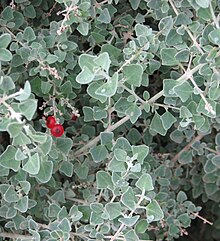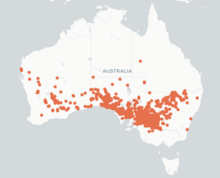| Chenopodium curvispicatum | |
|---|---|

| |
| Scientific classification | |
| Kingdom: | Plantae |
| Clade: | Tracheophytes |
| Clade: | Angiosperms |
| Clade: | Eudicots |
| Order: | Caryophyllales |
| Family: | Amaranthaceae |
| Genus: | Chenopodium |
| Species: | C. curvispicatum |
| Binomial name | |
| Chenopodium curvispicatum Paul G. Wilson | |
Chenopodium curvispicatum is a species of plant in the family Amaranthaceae, endemic to Australia.
It is a small Australian native shrub species of Chenopodium genus, which occurs in semi-arid and arid areas of Western Australia, South Australia, Victoria and New South Wales. It is often referred to as cottony saltbush.
Etymology and naming
The word curvispicatum is in reference to the shape of the panicles, which appear as drooping spikes. Common names include cottony saltbush, and cottony goosefoot. The species is often erroneously referred to in literature as Cheopodium gaudichaudianum, and also in hiberia as C. desertorum and Rghagodia spinescenus.

Description
Chenopodium curvispicatum grows to 1m high in the form of a straggly shrub, and features slender drooping branches with dense vesicular hairs. The leaves are opposite or sub-opposite, with deltoid shaping profiles and are 1 to 1.5 cm long and wide, and are covered with white rounded hairs which appear as a silverly layer. The flowers are either male or bisexual with pyramidal panicles 2–5 cm long. The female flowers are found below the male, and the fruit is enveloping until mature when it opens to 5mm diameter and becoming red. The fruit is a berry which contains sap, and changes from red to orange as it dries.
Taxonomy
Chenopodium curvispicatum is a member of the Caryophyllales order, within the Chenopodiaceae family.
Ecology
Chenopodium curvispicatum is found in well drained calcareous limestone soils within semi-arid and sand plain woodlands. Many of these areas have become degraded due to overgrazing, as well as being impacted by feral species including goats and rabbits. Chenopodium family plants form key understorey components of plant communities. In these arid environments, understorey shrubs provide valuable habitat and resources for many species of herbs and grasses.
A typical plant community type featuring common associations with Chenopodium curvispicatum is the Casuarina pauper/Alectryon oleifolius woodland and Eucalyptus shrublands in semi-arid areas within Nanya Station in western New South Wales. These ecological communities form unique examples of intact vegetation communities rarely found in New South Wales.
Reproduction/dispersal
The seeds are rounded at 1.5mm diameter, with a honeycomb matrix and are black in colour. The seeds disperse from fruiting flowers between March and September.
References
- "Chenopdium curvispicatum". Australian Plant Name Index (APNI), IBIS database. Centre for Plant Biodiversity Research, Australian Government, Canberra. Retrieved 16 February 2009.
- ^ "Chenopodium curvispicatum Paul G.Wilson". PlantNET - New South Wales Flora Online. Royal Botanic Gardens & Domain Trust, Sydney Australia. Retrieved 16 February 2009.
- ^ Australia, Atlas of Living. "Species: Chenopodium curvispicatum (Cottony Saltbush)". bie.ala.org.au. Retrieved 24 October 2023.
- ^ Western Australian Herbarium (1983). Nuytsia: journal of the Western Australian Herbarium. Vol. v.4:no.2 (1983). Perth, W.A: Department of Biodiversity, Conservation and Attractions.
- BUREAU OF FLORA AND FAUNA (1984). Flora of Australia - Volume 4 Phytolaccaceae to Chenopodiaceae (PDF). Australian Government Publishing Service.
- "Semi-arid Sand Plain Woodlands | NSW Environment, Energy and Science". www.environment.nsw.gov.au. Retrieved 24 October 2023.
- The State of Victoria Department of Environment, Land, Water and Planning (2021). "Victorian semi-arid woodlands" (PDF).
{{cite web}}: CS1 maint: multiple names: authors list (link) - ^ Westbrooke, Martin E. (2007). "NANYA STATION, WESTERN NEW SOUTH WALES VEGETATION, FLORA AND FAUNA" (PDF). University of Ballarat.
- "VicFlora: Chenopodium curvispicatum". vicflora.rbg.vic.gov.au. Retrieved 24 October 2023.
This Amaranthaceae article is a stub. You can help Misplaced Pages by expanding it. |
This Australian eudicot article is a stub. You can help Misplaced Pages by expanding it. |